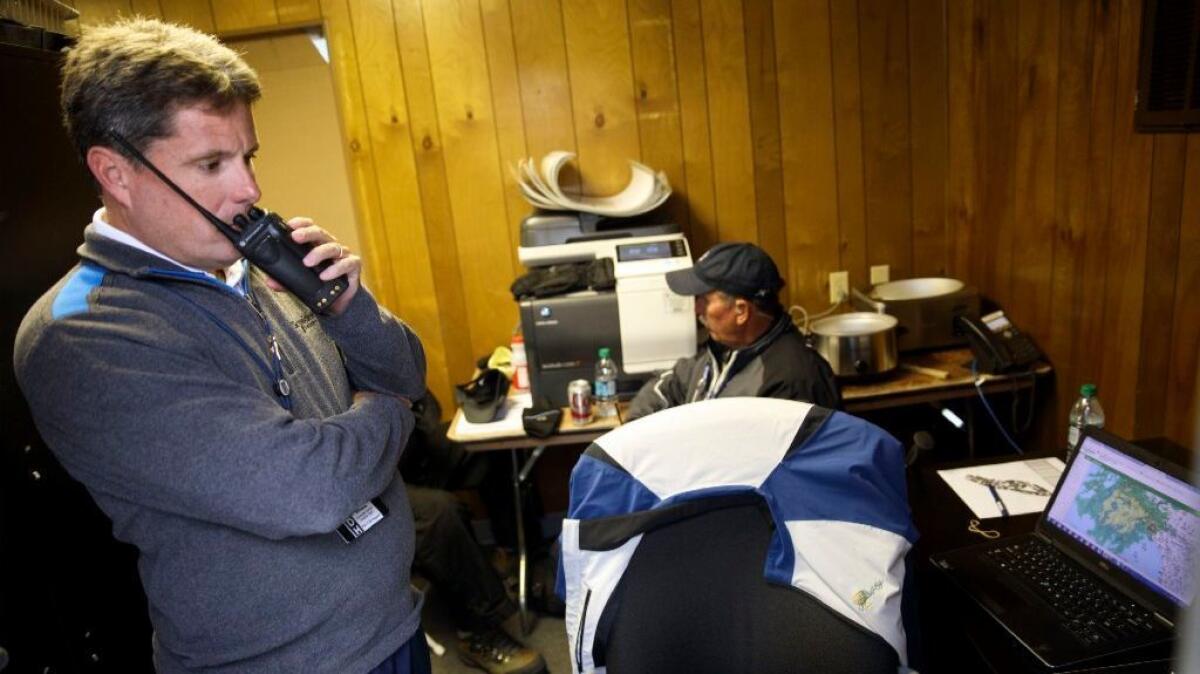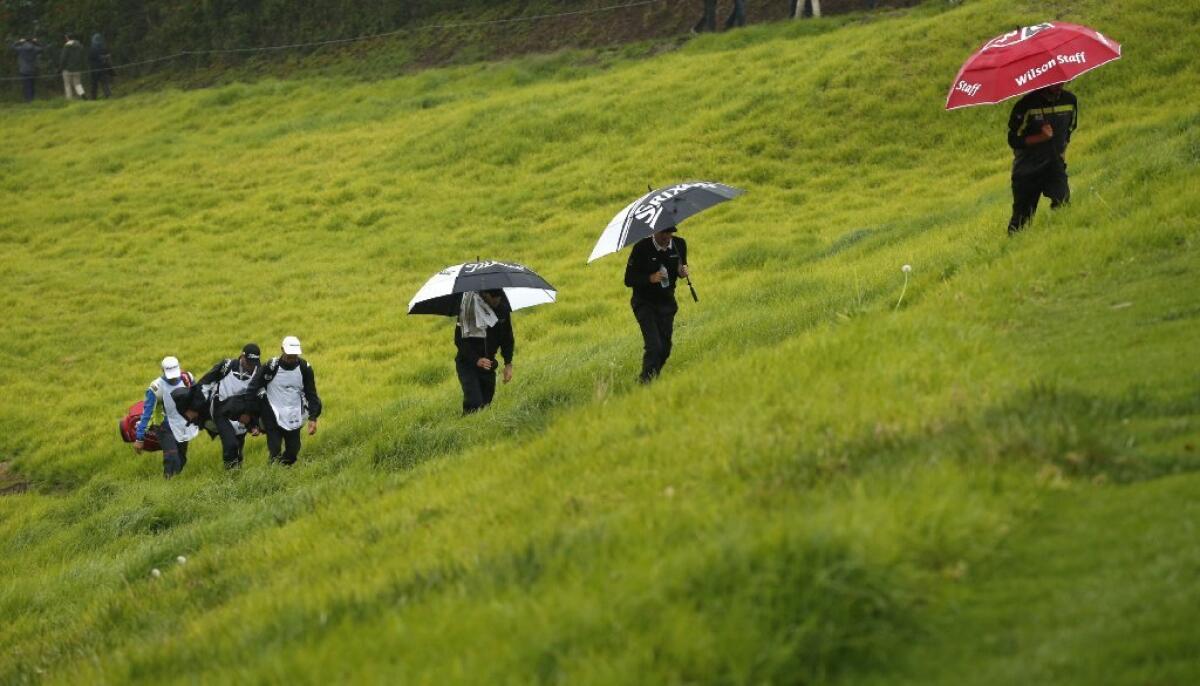The man the PGA Tour goes to for its weather forecast

Stewart Williams arrived at his cramped trailer on a Riviera Country Club tennis court at 5 a.m. Friday. He sat in front of two laptops, a copier to his left, a handheld radio, cup of coffee and breakfast burrito to his right. Not much room for anything else.
He bought the burrito from the food truck just outside his door in the small city of vans and trailers that serve TV crews and volunteers for the Genesis Open. He could have walked to the media dining tent and gotten a free breakfast, but that would have meant 15 minutes away from his laptops. He couldn’t afford the time.
Williams, 47, is a meteorologist who works about 26 tournaments a year for the PGA Tour. He’s been doing it for 20 years; it’s a passion for him. And he’s had a very busy week.
Friday, he spent more than seven hours looking at the foreboding information in front of him. He infrequently took his eyes off his screens, toggling between one Doppler radar program and another, checking wind readings and electrical field meters for lightning, continually looking at the massive weather system that was going to hammer Southern California at some point Friday morning.
How big was the storm bearing down on the area?
“Oh, it’s a 10, on a scale of one to 10,” he said.
Of course, he was right. He usually is.
“This is what I do,” the North Carolina resident said. “I sit and I watch.”
Williams, who earned a degree in meteorology from North Carolina Asheville in 1992, had known for several days that a storm system bringing high winds and perhaps five or more inches of rain was headed this way. The question was when.

Mark Russell, the tour’s vice president of rules and competition, and Williams met very early Friday. They talk over the radio frequently whenever weather is an issue.
Russell is responsible for setting up the tournament and calling off play if conditions demand. Williams is his go-to weather guy.
“We knew the rain and wind were coming,” said Russell, hopeful at the time that the 48 players who didn’t finish the first round Thursday could complete their rounds Friday morning.
“We were extremely fortunate to get as far as we got…. I was expecting to come in here this morning and maybe not even be able to play.”
The play lasted for more than five hours Friday, but that wasn’t clear at the start of the day.
7 a.m.: Williams radios Russell that a storm cell is approaching and should hit in 20-30 minutes, but because it’s moving at 70 mph, the rain shouldn’t last long and play should continue. The main storm is still just west and north. It could land within a few hours, though.
“Between now and 10, I think we’ll be OK,” Williams says. “We should get the first round in.”
How’s the rest of the day look?
“It’ll go downhill from here,” Williams says.
As the first round ends, tour officials put the pins in new positions for the second round. Because of the forecast, pins were put on high spots, so that when the rain hit, puddles wouldn’t form around the cups.
“We try to give every advantage to the players so we can get as much play as possible,” Williams says.
“We can keep playing in rain until the course condition dictates we can’t play anymore.”
7:28: Russell calls to ask about the approaching cell. Williams says it’s 15 miles away. Wind outside the trailer is picking up.
7:30: Williams looks at wind measuring programs. Gusts at 53 mph on Santa Rosa Island, 48 mph in Bakersfield. “Not good golf weather,” he says.
7:40: Williams reports to Russell: “Guys, good news. I think the heaviest rain [in the small cell] is going north of us.” Outside, it’s beginning to rain more heavily, but not enough to stop play.
7:45: Dennis Paulson of PGA Tour Radio enters the trailer to get an on-air update. Williams is smooth with a report that looks promising for a while, very bleak after that. “It’s coming,” he says. “It’s not so bad right now, but that’ll change.”
Paulson, a former tour player who won the Buick Classic in 2000, knows that weather can be unfair to golfers, that they don’t love coming back to complete a round in miserable conditions when many other players finished their round under perfect conditions the day before.
“That’s just the nature of what it is,” Paulson says. “We’re not playing under a roof.”
Play continues despite growing wind and light rain. But the course is still in fine shape.
9:40: “We’ve been staying right on the edge” of the storm, Williams reports in another call. “The longer we stay on the edge, the better.
“If we play four or five hours today, that really takes the pressure off tomorrow…. Heavy rain is still to the west. Hopefully we can keep going for another hour or two.”
Noon: The rain has intensified. Wind is gusting well into the 30s. “We’re going to call it shortly,” Williams says. “It’s only going to get worse…. If I were a betting man, I wouldn’t have guessed we’d get in as much play as we did.”
It’s clear that once play is suspended, that’s it for the day. The size of this system gives no hope that the course will be playable any time Friday.
“There’s no point in asking players to hang around all afternoon,” Williams says. “And it’s safer to get everyone off the course.”
A large eucalyptus limb has fallen near the 15th tee but no one is injured.
12:10 p.m.: Russell enters the trailer. He understands they’ve gotten in all the play they could possibly get and decides to call it, allowing players on a couple of holes to hit their tee shots. Under the tour’s rules, when play is suspended, players are allowed to complete any hole they have already started. This might clear a little more space for Saturday.
12:18: Russell is on the radio with the six other tour officials on the course. “On my three count,” he says. “One, two, three…”
At that point air horns from the six officials sound around Pacific Palisades. Play is suspended for the day.
Williams gets ready to call it a day. He’ll be back very early Saturday, watching the laptop screens, hoping to deliver better news.
More to Read
Go beyond the scoreboard
Get the latest on L.A.'s teams in the daily Sports Report newsletter.
You may occasionally receive promotional content from the Los Angeles Times.











